I should remind myself not to listen to the media (even the public broadcaster) when…
Australian labour market goes backwards in April
Yesterday, the Australian Bureau of Statistics released the latest – Wage Price Index, Australia – for the March-quarter 2021, which showed that wages growth remains low in Australia. I will analyse that next week separately because there are some interesting policy principles involved. Today, the ABS put out the latest – Labour Force, Australia – for April 2021 and while unemployment fell by 0.3 points, this was all down to the decline in participation as employment plunged by 30,600. Unemployment rate would have been 70.3 thousand higher had not the participation rate fallen (that is the rise in hidden unemployment) and the unemployment rate would have been 6 per cent rather than the official 5.5 per cent. Monthly hours of work declined by 13 million hours (0.7 per cent). The design of fiscal stimulus packages requires a careful assessment of when it is right to taper them and/or withdraw them altogether. In this neoliberal era, governments who reluctantly provide stimulus during bad times, tend to withdraw the support too early. The current evidence suggests that is once again the case here. Further, uncertainty has now reached new heights as a result of the vaccination bungling by the federal government. Overall, the recovery is still too slow and more government support by way of large-scale job creation is needed.
The summary ABS Labour Force (seasonally adjusted) estimates for April 2021 are:
- Employment decreased 30,600 (-0.2 per cent) – Full-time employment increased by 33,800 and part-time employment decreased by 64,400.
- Unemployment decreased 33,600 to 756,200 persons.
- The official unemployment rate decreased 0.2 points to 5.5 per cent.
- The participation rate decreased by 0.3 points to 66 per cent.
- Aggregate monthly hours worked decreased 13 million hours (-0.7 per cent).
- Underemployment decreased by 0.2 points to 7.8 per cent (a fall of30 thousand). Overall there are 1,072.1 thousand underemployed workers. The total labour underutilisation rate (unemployment plus underemployment) decreased by 0.3 points to 13.3 per cent. There were a total of 1,828.4 thousand workers either unemployed or underemployed.
Employment contracts in April 2021
1. Employment growth was -0.2 per cent with 30,600 (net) jobs disappearing on the back of the withdrawal of the JobKeeper scheme.
2. Full-time employment increased by 33,800 and part-time employment decreased by 64,400.
3. Despite the contraction this month, employment in Australia is now above the February 2020 level by 45.3 thousand (0.3 per cent). However, some sectors are still languishing while others are rebounding strongly.
The following graph shows the month by month growth in full-time (blue columns), part-time (grey columns) and total employment (green line) for the 24 months to April 2021 using seasonally adjusted data.
The following table provides an accounting summary of the labour market performance over the last six months to provide a longer perspective that cuts through the monthly variability and provides a better assessment of the trends.
Assessment:
1. Total employment has risen by 292.3 thousand and 13.8 per cent of that increase has been in part-time work.
2. Full-time employment has now passed the February 2020 level by 21.1 thousand.
Given the variation in the labour force estimates, it is sometimes useful to examine the Employment-to-Population ratio (%) because the underlying population estimates (denominator) are less cyclical and subject to variation than the labour force estimates. This is an alternative measure of the robustness of activity to the unemployment rate, which is sensitive to those labour force swings.
The following graph shows the Employment-to-Population ratio, since February 2008 (the low-point unemployment rate of the last cycle).
It fell with the onset of the GFC, recovered under the boost provided by the fiscal stimulus packages but then went backwards again as the Federal government imposed fiscal austerity in a hare-brained attempt at achieving a fiscal surplus in 2012.
The ratio fell by 0.2 points in April 2021 to 62.3 per cent on the back of the fall in employment. The ratio is now 0.5 points below pre-GFC peak in April 2008 of 62.9 per cent.
To put the current monthly performance into perspective, the following graph shows the average monthly employment change for the calendar years from 1980 to 2020 (to date).
1. The labour market weakened considerably over 2018 and that situation worsened in 2019.
2. The average employment change over 2020 was -7.5 thousand.
3. So far in 2021, the average monthly change is 41 thousand and you can see that from the graph that this is exceptional, although it has only been for 4 months so far as businesses return to more normal levels of operation.
The following graph shows the average monthly changes in Full-time and Part-time employment (lower panel) in thousands since 1980.
The interesting result is that during recessions or slow-downs, it is full-time employment that takes the bulk of the adjustment. Even when full-time employment growth is negative, part-time employment usually continues to grow.
However, this crisis is different because much of the employment losses are the result of lockdown and enforced business closures in sectors where part-time employment dominates.
Hours worked decreased 12.8 million hours (-0.7 per cent) in April 2021
The following graph shows the monthly growth (in per cent) over the last 24 months.
The dark linear line is a simple regression trend of the monthly change – which depicts slightly positive trend.
Unemployment decreased 33,600 to 756,200 persons
The official unemployment rate fell 0.2 points to 5.5 per cent in the face of the employment contraction. Which means that the drop in unemployment was all due to the fall in the participation rate.
That means that hidden unemployment has risen somewhat.
The following graph shows the national unemployment rate from February 1980 to April 2021. The longer time-series helps frame some perspective to what is happening at present.
Assessment:
1. There is still considerable slack in the labour market that could be absorbed with further fiscal stimulus. Unemployment remains 61.5 thousand above the February 2020 level.
Aggregate participation rate decreased by 0.3 points to 66 per cent
The fall in the labour force participation rate means that the labour force fell by 64.2 thousand in April 2021.
Given employment fell by 30,600, less than the contraction in labour supply (in persons), unemployment fell by 33,600.
How much would unemployment have changed had the participation rate had not fallen? Which really could also be framed as by how much did hidden unemployment rise in April 2021.
We can make two calculations:
1. Just the monthly implication.
2. The implication of the participation rate being below its most recent peak of 66.2 per cent in August 2019.
The labour force is a subset of the working-age population (those above 15 years old). The proportion of the working-age population that constitutes the labour force is called the labour force participation rate. Thus changes in the labour force can impact on the official unemployment rate, and, as a result, movements in the latter need to be interpreted carefully. A rising unemployment rate may not indicate a recessing economy.
The labour force can expand as a result of general population growth and/or increases in the labour force participation rates.
The following Table shows the breakdown in the changes to the main aggregates (Labour Force, Employment and Unemployment) and the impact of the rise in the participation rate.
The change in the labour force in April 2021 was the outcome of two separate factors:
- The underlying population growth added 6.1 thousand persons to the labour force. The population growth impact on the labour force aggregate is relatively steady from month to month but has slowed in recent months due to the border restrictions and the impact they have had on migration rates; and
- The fall in the participation rate meant that there were 70.3 thousand workers who left the labour force (relative to what would have occurred had the participation rate remained unchanged).
- The net result was that the labour force fell by 64.2 thousand.
Assessment:
1. If the participation rate had not have fall in April 2021, total unemployment, given the current employment level, would have been 826.5 thousand rather than the official count of 756.2 thousand as recorded by the ABS – a difference of 70.3 thousand workers (the ‘participation effect’).
2. Without the fall in the participation rate in April 2021, the official unemployment rate would have been 6 per cent (rounded) rather than its current value of 5.5 per cent).
3. If we consider the changes since August 2019, then the labour force has risen by only 153.8 thousand while employment has risen (net) by 110.2 thousand, which is why unemployment is 39.2 thousand higher than it would have been and the unemployment rate would be 5.7 per cent rather than 5.5 per cent had those workers not dropped out of the labour force as a result of inadequate job opportunities.
Broad labour underutilisation decreased by 0.3 points to 13.3 per cent in April 2021
The results for April 2021 are (seasonally adjusted):
1. Underemployment decreased by 30 thousand.
2. The underemployment rate fell by 0.2 points to 7.8 per cent.
2. Overall there are 1,072.1 thousand underemployed workers.
3. The total labour underutilisation rate (unemployment plus underemployment) decreased by 0.3 points to 13.3 per cent but don’t forget that hidden unemployment rose, which means this decline is rather illusory.
4. There were a total of 1,828.4 thousand workers either unemployed or underemployed.
The following graph plots the seasonally-adjusted underemployment rate in Australia from February 1980 to the April 2021 (blue line) and the broad underutilisation rate over the same period (green line).
The difference between the two lines is the unemployment rate.
The three cyclical peaks correspond to the 1982, 1991 recessions and the more recent downturn.
The other difference between now and the two earlier cycles is that the recovery triggered by the fiscal stimulus in 2008-09 did not persist and as soon as the ‘fiscal surplus’ fetish kicked in in 2012, things went backwards very quickly.
The two earlier peaks were sharp but steadily declined. The last peak fell away on the back of the stimulus but turned again when the stimulus was withdrawn.
With the participation falling this month, I expect a slight rise in hidden unemployment. Please read my blog post – Australian labour underutilisation rate is at least 13.4 per cent – for more discussion on this point.
Unemployment and broad labour underutilisation indexes – last four downturns
The following graph captures the evolution of the unemployment rates for the 1982, 1991, GFC and COVID-19 downturns.
For each episode, the graph begins at 100 – which is the index value of the unemployment rate at the low-point of each cycle (June 1981; December 1989; February 2008, and February 2020, respectively).
We then plot each episode out for 90 months.
For 1991, the peak unemployment which was achieved some 38 months after the downturn began and the resulting recovery was painfully slow. While the 1982 recession was severe the economy and the labour market was recovering by the 26th month. The pace of recovery for the 1982 once it began was faster than the recovery in the current period.
During the GFC crisis, the unemployment rate peaked after 16 months (thanks to a substantial fiscal stimulus) but then started rising again once the stimulus was prematurely withdrawn and a new peak occurred at the 80th month.
The COVID-19 downturn was obviously worse than any of the previous recessions shown but because of its unique nature – the job losses being largely driven by lockdowns etc.
And the recovery is evident.
The graph provides a graphical depiction of the speed at which each recession unfolded (which tells you something about each episode) and the length of time that the labour market deteriorated (expressed in terms of the unemployment rate).
After 14 months, the unemployment had risen from 100 to:
1. 130.5 index points in 1982 and rising.
2. 147.4 index points in 1991 and rising.
3. 138.5 index points in the GFC and rising.
4. 106.7 index points currently and falling.
Note that these are index numbers and only tell us about the speed of decay rather than levels of unemployment.
The next graph performs the same operation for the broad labour underutilisation rate (sum of official unemployment and underemployment).
Teenage labour market improves in April 2021
The following Table shows the distribution of net employment creation in the last month and the last 12 months by full-time/part-time status and age/gender category (15-19 year olds and the rest).
To put the teenage employment situation in a scale context (relative to their size in the population) the following graph shows the Employment-Population ratios for males, females and total 15-19 year olds since June 2008.
You can interpret this graph as depicting the loss of employment relative to the underlying population of each cohort. We would expect (at least) that this ratio should be constant if not rising somewhat (depending on school participation rates).
1. The male ratio has fallen by 8.5 percentage points since February 2008, but is now 0.5 points above its level in March 2020. It rose by 1.6 points over the month.
2. The female ratio has fallen by 0.9 percentage points since February 2008, is now 3.3 points above its level in March 2020. It rose by 0.74 points over the month.
3. The overall teenage employment-population ratio has fallen by 4.8 percentage points since February 2008, is now 1.8 points above its level in March 2020. It rose by 1.2 points over the month.
Conclusion
My standard monthly warning: we always have to be careful interpreting month to month movements given the way the Labour Force Survey is constructed and implemented.
The April 2021 data reveals that the Australian labour market has gone backwards with employment contracting, monthly hours worked contracting, and participation falling.
This is the first data since the Government withdrew its wage subsidy scheme (the JobKeeper) at the end of March.
The ABS said in their – – that:
The end of the JobKeeper wage subsidy did not have a discernible impact on employment between March and April.
They conceded that “”Some of the 31,000 fall in employment may relate to the end of JobKeeper, but it could also reflect usual month-to-month variation in the labour market and some larger than usual seasonal changes similar to those we saw earlier in the year.”
So we will have to wait a little longer to assess the impact of that withdrawal.
My overall assessment is:
1. Total employment is now above where it was in February 2020 but there are major sectoral differences – some sectors are still in deep recession while others are booming.
2. Unemployment fell but that was all down to the fall in participation which means that hidden unemployment rose by around 70 thousand or 0.5 points.
3. There is plenty of scope for further fiscal support without triggering any inflationary pressures.
That is enough for today!
(c) Copyright 2021 William Mitchell. All Rights Reserved.
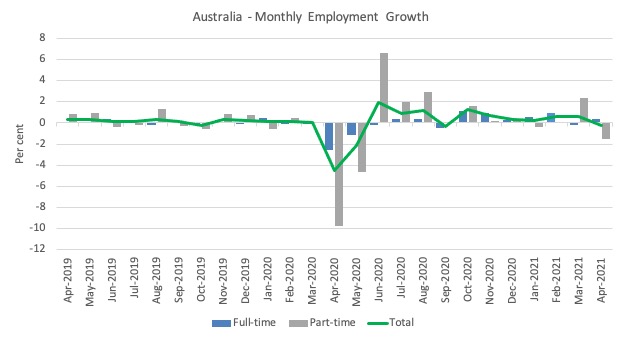
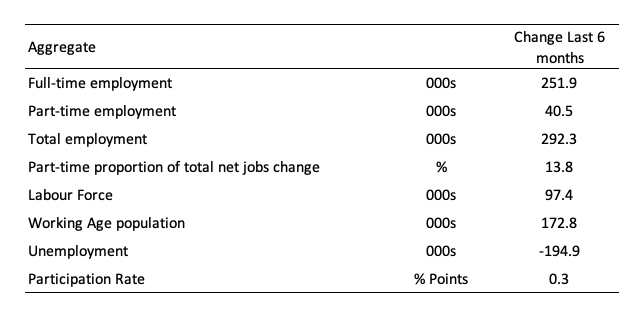
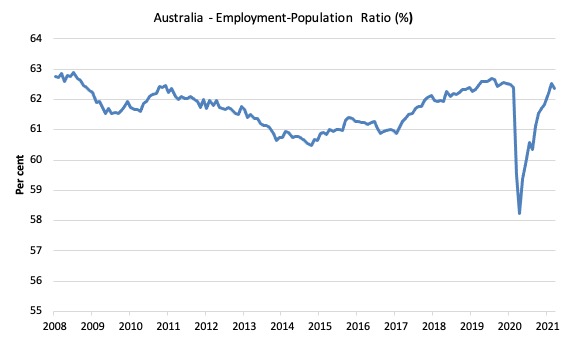
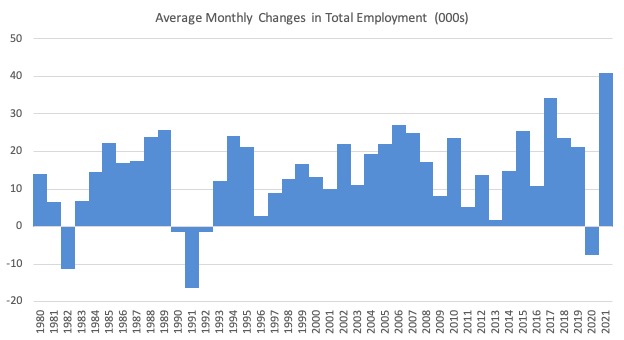
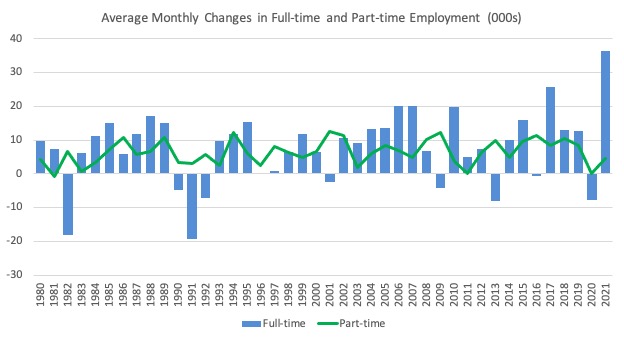
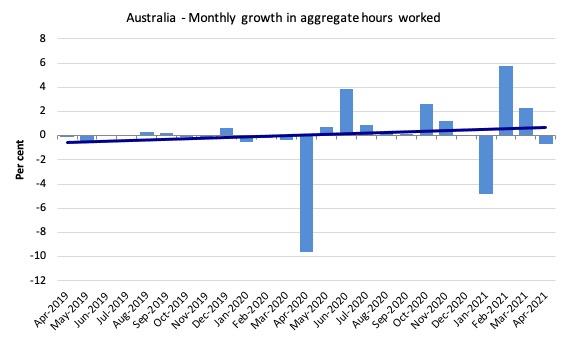
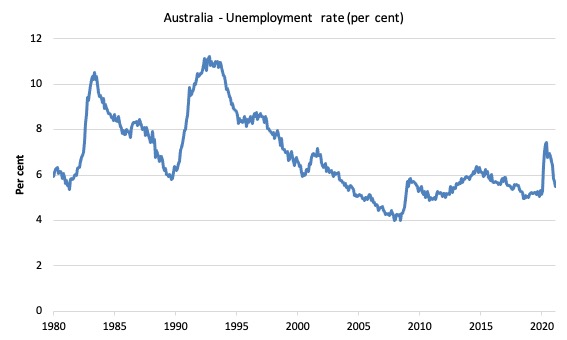
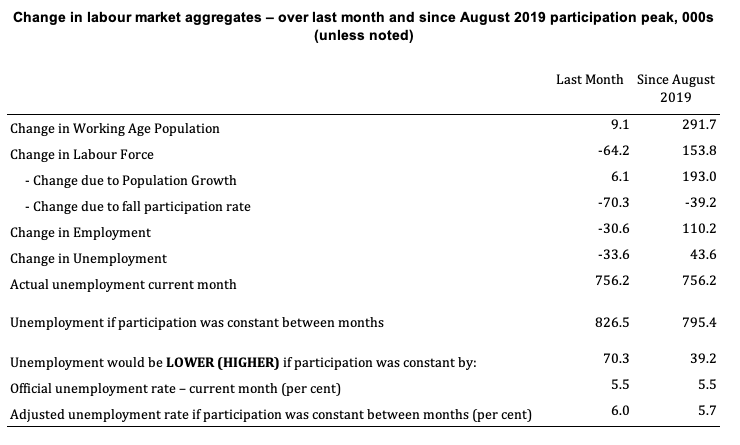
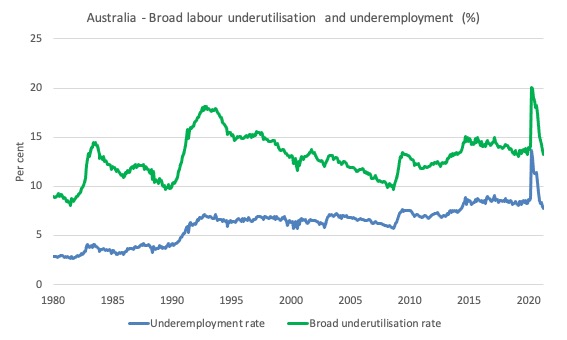
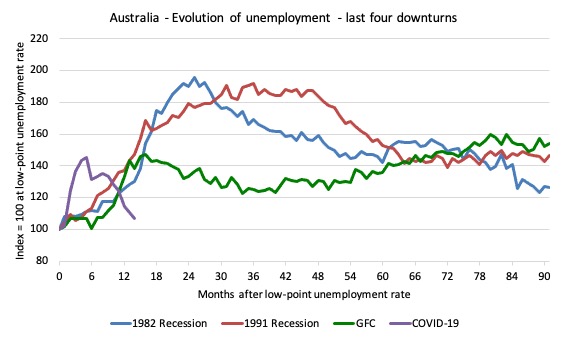
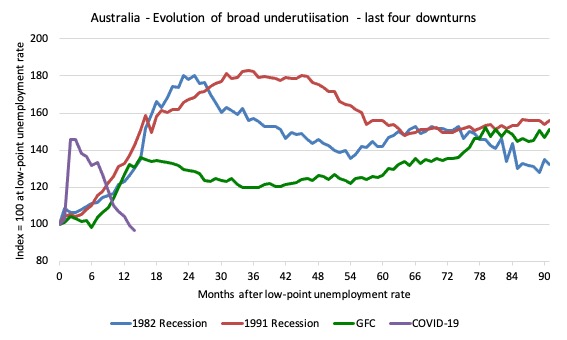
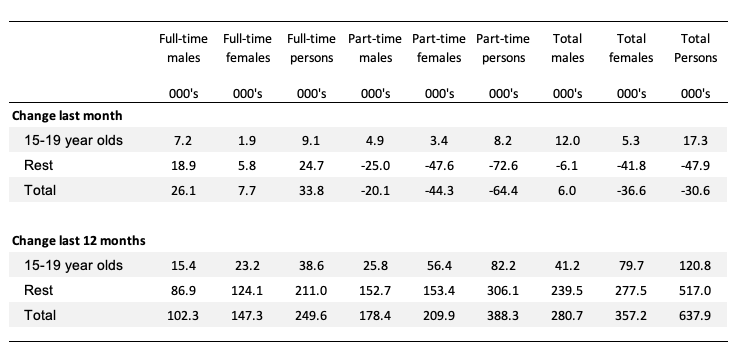
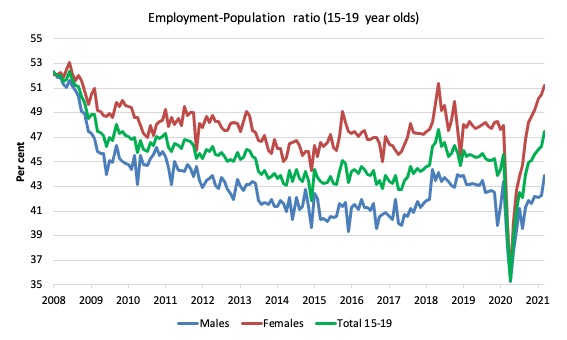
This Post Has 0 Comments